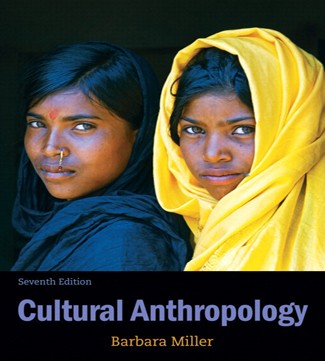Cultural Anthropology 7th Edition Miller Test Bank
$35.00 Original price was: $35.00.$26.50Current price is: $26.50.
Cultural Anthropology 7th Edition Miller Test Bank
This is completed downloadable of Cultural Anthropology 7th Edition Miller Test Bank

Product Details:
- ISBN-10 : 0205260012
- ISBN-13 : 978-0205260010
- Author: Barbara D. Miller
Through clear writing, a balanced theoretical approach, and engaging examples, Cultural Anthropology stresses the importance of social inequality and human rights, the environment, culture change and applied aspects of anthropology. Rich examples of gender, ethnicity, race, class, and age thread through the topical coverage of economic systems, the life-cycle, health, kinship, social organization, politics, language, religion, and expressive culture. In addition, the last two chapters address how migration is changing world cultures and how the importance of local cultural values and needs are shaping international development policies and programs.
Table of Content:
Chapter 3 Researching Culture
In this revision of the testbank, all of the questions have been updated to reflect changes in Cultural Anthropology 7e. There is also a new system for identifying the difficulty of the questions. In this revision, the questions are now tagged according to the four levels of learning that help organize the text. Think of these four levels as moving from lower-level to higher-level cognitive reasoning. The four levels are:
REMEMBER: a question involving recall of key terms or factual material
UNDERSTAND: a question testing comprehension of more complex ideas
APPLY: a question applying anthropological knowledge to some new situation
ANALYZE: a question requiring identifying elements of an argument and their interrelationship
Types of Questions
Easy to Difficult Level of Difficulty
| Multiple Choice And True/False | Short Answer And Essay | Total Questions | |
| Remember | 29 | 10 | 39 |
| Understand | 15 | 6 | 21 |
| Apply | 2 | 7 | 9 |
| Analyze | 1 | 7 | 8 |
| 47 | 30 | 77 |
MULTIPLE CHOICE. Choose the one alternative that best completes the statement or answers the question.
- One thing about which most cultural anthropologists agree is __________.
A that anthropologists should study primarily people’s thoughts and ideas
B that culture is genetically determined
C the definition of culture
D the importance of doing fieldwork
E whether anthropological fieldwork should proceed inductively or deductively
(UNDERSTAND; Answer: D; p. 58)
- On the basis of his experience in the Trobriand Islands during World War I, Bronislaw Malinowski is generally considered to be __________.
A the “father” of participant observation
B the founder of the etic approach
C the first person to realize that no culture is more or less “civilized” than another
D the first person to define the concept of culture
E the first person to do fieldwork in his own culture
(REMEMBER; Answer: A; p. 59)
- Given current globalization and the rarity of small, isolated cultures, many contemporary cultural anthropologists have abandoned __________.
A fieldwork
B learning a non-Western language
C the concept of holism
D the concept of cultural relativism
E participant observation
(UNDERSTAND; Answer: C; p. 59)
- The research method in cultural anthropology that involves living in a culture for an extended period while gathering data is __________.
A the inductive method
B archival research
C participant observation
D life history
E the interview method
(REMEMBER; Answer: C ; p. 59)
- In the Trobriand Islands, the British colonialists substituted which activity for local warfare?
A Christianity
B the kula
C village dances
D boat racing
E cricket
(REMEMBER; Answer: E; p. 60)
- Trobriand women’s most prized material items are __________.
A skirts
B pigs
C shell necklaces
D grass mats
E none of the above: only Trobriand men have material goods of value
(REMEMBER Answer A; p. 60)
- Compared to Malinowski’s research in the Trobriands, Weiner’s restudy addressed __________.
A women’s lives
B changing leadership patterns
C the rise of HIV/AIDS
D the decline of the kula trade
E the high rate of suicide
(REMEMBER; Answer: A; p. 62)
- During his fieldwork in Pakistan, a major challenge for Richard Kurin was __________.
A learning proper rules of gift exchange
B false role assignments
C learning the language
D not having a wife or children, which would have made him an “adult”
E learning proper rules of greeting
(REMEMBER; Answer: B; p. 65)
- When doing fieldwork, establishing rapport __________.
A is easier for male than female anthropologists
B is a waste of time when you could be conducting a survey instead
C usually happens during the first week
D makes life easier but doesn’t improve the quality of the information gathered
E can involve exchanging gifts with the local people
(UNDERSTAND; Answer: E; p. 65)
- During his fieldwork in Japan, Matthews Hamabata had a problem in terms of __________.
A learning to appreciate the food
B learning when to smile and when not to smile
C having to sit for long periods of time with his legs folded underneath him
D how to understand the meaning of a gift given to him and the appropriate response
E how to get people to tell him the truth
(REMEMBER; Answer: D; pp. 65-66)
- When Tony Whitehead, an African American anthropologist, did fieldwork in Jamaica, he was surprised that __________.
A he was unable to speak easily with the people because of his American English
B people thought he was much older than he was
C people expected him to bring his family with him and found it difficult to accept him as a lone male
D people assigned him to a high status
E none of the above: Whitehead’s fieldwork proceeded with no surprises since he was of the same “race” as the people he was studying
(REMEMBER; Answer: D; p. 66)
- Culture shock occurs when __________.
A an anthropologist finds that he/she learns the local language more easily than expected
B you discover, to your surprise, that you really like living in another culture
C a person has shifted from one culture to another
D two different cultural groups compete with each other
E all of the above
(UNDERSTAND; Answer: C; p. 67)
- Research that is guided by a hypothesis is __________.
A emic
B deductive
C holistic
D inductive
E prescriptive
(REMEMBER; Answer: B; p. 68)
- The Hawthorne effect refers to__________.
A the tendency for men to answer questions on behalf of women
B the stage that comes in fieldwork after culture shock when the researcher begins to feel comfortable
C biases in the data when the researcher doesn’t know the language well
D the tendency for respondents to avoid telling the truth about private matters
E the tendency for respondents to change their behavior to correspond with the researcher’s interests
(REMEMBER; Answer: E; p. 68)
- Interpretivist anthropologists tend to favor which kind of research approach?
A inductive
B deductive
C etic
D applied
E predictive
(APPLY; Answer: A; p. 68)
- An emic approach focuses on __________.
A what people in the study area say about their own culture
B gathering data on culturally shared rules for behavior
C explanations for culture offered by members of that culture
D events that have meaning for members of a particular culture
E all of the above
(UNDERSTAND; Answer: E; p. 68)
- The life history approach __________.
A is more successful for women respondents than men since women have more time
B has been rejected in cultural anthropology as too unreliable
C was popular in the nineteenth century but has been abandoned as too time-consuming
D is favored by anthropologists who seek quantitative data for large populations
E none of the above
(UNDERSTAND; Answer: E; pp. 69–70)
- __________ is a cluster name for many indigenous peoples who live in the eastern Canadian Arctic.
A Eskimo
B Neanderthal
C Sri Lankan
D Inuit
E Trobriand
(REMEMBER; Answer: D; p. 72)
- People’s naming of places is called __________.
A rapport
B toponymy
C numerology
D topography
E ethnocentrism
(REMEMBER; Answer: B ; p. 72)
- Inuit place naming is an example of __________.
A indigenous knowledge
B cultural relativism
C globalization
D clash of civilizations
E leveling mechanism
(UNDERSTAND; Answer: A; p. 72)
- An ethnography is __________.
A the main way cultural anthropologists present their findings about culture
B a descriptive writing about a culture
C an important aspect of anthropological research
D all of the above
E none of the above
(UNDERSTAND; Answer: D; p. 75)
- According to the code of ethics of the American Anthropological Association, the anthropologist’s first responsibility is to __________.
A protect the people studied from harm related to the research
B the agency that funded the study since they are the ones who paid for it
C the home country of the anthropologist
D the host government in the country where the research is conducted
E the United Nations
(REMEMBER; Answer: A; p. 76)
- A major catalyst to the adoption of a code of ethics by the American Anthropological Association was __________.
A the decline of small, isolated populations and increase in research in “modern” cultures
B the increasing proportion of anthropologists from non-Western cultures who supported a code of ethics
C World War II
D the Vietnam-American War
E the realization that “native” peoples were learning to read and would be able to comment on anthropological writings
People Also Search:
cultural anthropology 7th edition miller
cultural anthropology barbara miller
cultural anthropology chapter 7 quizlet
Related products
Test Bank
Test Bank for Decision Support and Business Intelligence Systems, 9th Edition: Efraim Turban
Test Bank
Test Bank for Operating Systems: Internals and Design Principles, 7th Edition: William Stallings
Test Bank
Test Bank for Clinical Immunology and Serology A Laboratory Perspective, 3rd Edition: Stevens











